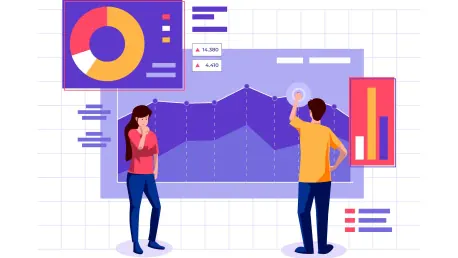The global data analytics market has seen explosive growth, driven by advancements in the Internet of Things (IoT), cloud computing, and artificial intelligence (AI). Research from GlobalData projects that data volumes will exceed 175 zettabytes by 2025, skyrocketing from today’s levels. This remarkable growth is accompanied by an 11.1% compound annual growth rate (CAGR) between 2023 and 2028, predicting the market to reach a staggering total value of $190 billion by 2028. Such a massive influx of data presents both unprecedented opportunities and challenges for businesses worldwide.
The recent innovations in data analytics span across several domains such as hardware, data management, applications, and delivery mechanisms. One of the pivotal advancements has been prescriptive analytics, a step beyond traditional descriptive and predictive analytics. While descriptive analytics explains past events and predictive analytics anticipates future outcomes, prescriptive analytics involves providing actionable recommendations. This cutting-edge technology uses sophisticated machine learning techniques to analyze large datasets and evaluate various “what if” scenarios, offering tangible pathways to optimize decision-making processes.
Revolutionizing Decision-Making with Prescriptive Analytics
Prescriptive analytics represents a considerable shift in how organizations handle and derive value from data. Imagine a scenario where a retail company can not only predict a decline in sales but also receive tailored strategies to counteract this trend effectively. This is the promise of prescriptive analytics, where machine learning algorithms sift through enormous datasets and provide actionable insights that are both practical and strategic. It empowers businesses to take proactive measures rather than react to situations as they unfold.
Traditional data analytics vendors, including industry giants like SAS, IBM, Oracle, and SAP, are constantly innovating to keep pace with the rapid evolution. However, AI-native vendors such as Cognitive Scale and ##O.ai are emerging as formidable competitors. These companies focus on automating complex operational decision-making processes through advanced machine learning techniques. Their solutions are designed to streamline and enhance the accuracy of these processes, providing a significant edge in a highly competitive environment. The integration of generative AI tools, exemplified by Microsoft’s Copilot, which incorporates ChatGPT into analytics platforms like Excel and PowerBI, underscores the transformative impact of AI across various analytics solutions.
Despite the advantages, the growth of prescriptive analytics and AI-driven solutions is not without challenges. Managing the vast amounts of data generated daily requires robust data governance frameworks to ensure data integrity, security, and compliance. Moreover, the intricacies involved in deploying advanced AI systems necessitate a thorough understanding and careful planning to avoid potential pitfalls such as data misuse.
Addressing Data Management and Security Concerns
The rapid increase in data volumes and the complexity of analytics raise significant concerns regarding data management, governance, and security. As organizations generate more data every day, ensuring that this data is managed correctly becomes critically important. Advanced AI systems that create detailed models and simulations from vast datasets increase the risk of sensitive data misuse. To mitigate these risks, stringent data governance frameworks must be instituted and rigorously maintained. These frameworks should cover every aspect of data management, from data collection and storage to access controls and data sharing protocols.
Further, to safeguard sensitive information, companies should implement advanced security measures such as encryption, anonymization, and real-time monitoring. AI-enabled tools can also play a crucial role in identifying potential security breaches and mitigating threats before they escalate. Establishing a culture of data privacy and security awareness within organizations is essential to counteract the evolving nature of cyber threats. Employee training programs focused on data security best practices can empower staff to become the first line of defense against potential breaches.
Demand for Skilled Data Professionals
As data analytics continues to grow, the demand for skilled data professionals is rising accordingly. Roles such as data scientists, data engineers, and specialists in data visualization, reporting, and communication are more sought after than ever. Companies are finding themselves in a race to attract, train, and retain talent capable of navigating the intricacies of modern data analytics.
Given the competitive landscape, businesses may also consider promoting the concept of citizen data scientists—encouraging less technical employees to receive training in data analysis skills. This approach not only broadens the available talent pool but also embeds a deeper understanding of data-driven strategies across the organization. By fostering a data-centric culture, businesses can mitigate the risks associated with a shortage of specialized talent and enhance their overall analytical capabilities.
Alternatively, strategic acquisitions or partnerships may be employed to fill the data-skills gap. Acquiring a company with a strong data analytics team or partnering with educational institutions to sponsor data science programs can offer a sustainable pipeline of skilled professionals. These strategies ensure that organizations remain competitive and can effectively leverage data to drive growth and innovation.
Future of Data-Driven Strategy
The global data analytics market has experienced explosive growth, fueled by advancements in the Internet of Things (IoT), cloud computing, and artificial intelligence (AI). According to research by GlobalData, data volumes are expected to surpass 175 zettabytes by 2025, a significant increase from current levels. This rapid growth corresponds with an 11.1% compound annual growth rate (CAGR) from 2023 to 2028, projecting the market to reach a staggering value of $190 billion by 2028. This massive data influx presents both unprecedented opportunities and challenges for businesses worldwide.
Recent innovations in data analytics cover numerous areas, including hardware, data management, applications, and delivery methods. A key advancement is prescriptive analytics, which goes beyond traditional descriptive and predictive analytics. Descriptive analytics explains past events, and predictive analytics forecasts future outcomes. In contrast, prescriptive analytics offers actionable recommendations by utilizing advanced machine learning techniques to analyze large datasets and evaluate various “what if” scenarios, ultimately optimizing decision-making processes.









